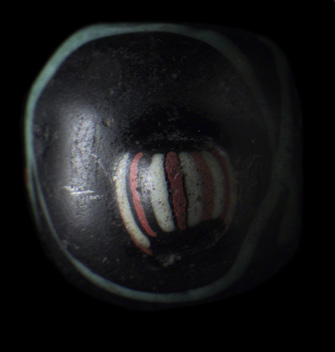 STUDIO PHOTOGRAPHS
STUDIO PHOTOGRAPHSIntroduction | Research | People | Tools
 STUDIO PHOTOGRAPHS
STUDIO PHOTOGRAPHS
GLASS BEAD (TYA 642: 2701)
Type: Half bead with crossing blue strips on black ground; on the side there is a small red-black-white striped knot.
Use: Jewel.
Site: Raisio, Ihala, Mulli abode.
Period: Viking Age / Crusade Age / Early Middle Ages
Dating: 980-1220 A.D.
Photographer: Antti Huittinen.
Beads like this were made in different colours by twisting molten glass. Probably they were manufactured in present Turkestan in Central Asia. They may have been imported into Northern Europe via trade-routes on the great rivers of Russia. The beads with black base colour were possibly made in the 10th century.
The first glass beads were manufactured in Syria around 5000 B.C. Glass is made of quartz sand and alkali (e.g. sodium carbonate or potash made of wood ashes). Glass beads have been manufactured of cold or heated glass. Pieces cut of cold melted glass can be polished like semiprecious stones. Beads of molten glass can be made by twisting heated glass on a metal skewer. In Finland, it is not until the 4th century A.D. that we find glass beads in necklaces.
Although there is no evidence of glass-making, there exists proof of glass-bead manufacturing in some Viking-Age cities in Scandinavia. In ancient Russian cities, glass-making became common when the Middle Ages approached. For example, manufacture of beads is known in Staraya Ladoga, on the south shore of Lake Ladoga, from the 8th century to the early 11th century. In Finland there is no evidence of manufacturing glass beads.
Other pictures:
Other related topics:
Introduction | Research | People | Tools